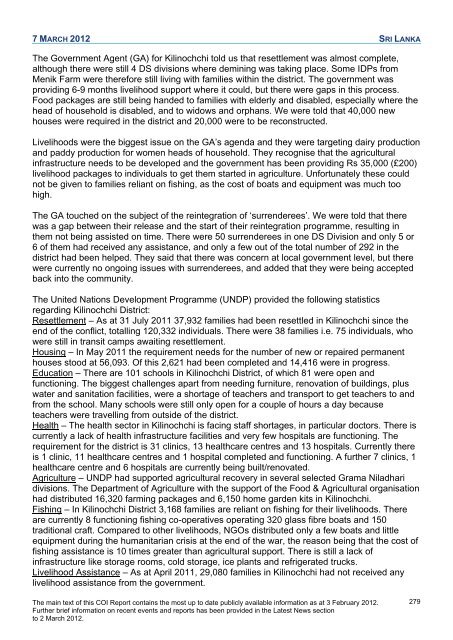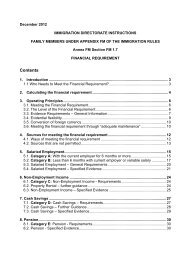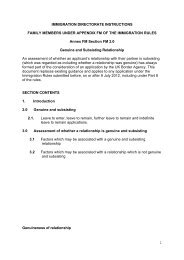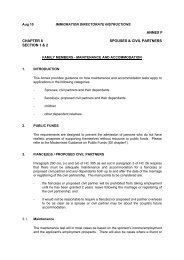COI Report March 2012 - UK Border Agency - Home Office
COI Report March 2012 - UK Border Agency - Home Office
COI Report March 2012 - UK Border Agency - Home Office
Create successful ePaper yourself
Turn your PDF publications into a flip-book with our unique Google optimized e-Paper software.
7 MARCH <strong>2012</strong> SRI LANKA<br />
The Government Agent (GA) for Kilinochchi told us that resettlement was almost complete,<br />
although there were still 4 DS divisions where demining was taking place. Some IDPs from<br />
Menik Farm were therefore still living with families within the district. The government was<br />
providing 6-9 months livelihood support where it could, but there were gaps in this process.<br />
Food packages are still being handed to families with elderly and disabled, especially where the<br />
head of household is disabled, and to widows and orphans. We were told that 40,000 new<br />
houses were required in the district and 20,000 were to be reconstructed.<br />
Livelihoods were the biggest issue on the GA‘s agenda and they were targeting dairy production<br />
and paddy production for women heads of household. They recognise that the agricultural<br />
infrastructure needs to be developed and the government has been providing Rs 35,000 (£200)<br />
livelihood packages to individuals to get them started in agriculture. Unfortunately these could<br />
not be given to families reliant on fishing, as the cost of boats and equipment was much too<br />
high.<br />
The GA touched on the subject of the reintegration of ‗surrenderees‘. We were told that there<br />
was a gap between their release and the start of their reintegration programme, resulting in<br />
them not being assisted on time. There were 50 surrenderees in one DS Division and only 5 or<br />
6 of them had received any assistance, and only a few out of the total number of 292 in the<br />
district had been helped. They said that there was concern at local government level, but there<br />
were currently no ongoing issues with surrenderees, and added that they were being accepted<br />
back into the community.<br />
The United Nations Development Programme (UNDP) provided the following statistics<br />
regarding Kilinochchi District:<br />
Resettlement – As at 31 July 2011 37,932 families had been resettled in Kilinochchi since the<br />
end of the conflict, totalling 120,332 individuals. There were 38 families i.e. 75 individuals, who<br />
were still in transit camps awaiting resettlement.<br />
Housing – In May 2011 the requirement needs for the number of new or repaired permanent<br />
houses stood at 56,093. Of this 2,621 had been completed and 14,416 were in progress.<br />
Education – There are 101 schools in Kilinochchi District, of which 81 were open and<br />
functioning. The biggest challenges apart from needing furniture, renovation of buildings, plus<br />
water and sanitation facilities, were a shortage of teachers and transport to get teachers to and<br />
from the school. Many schools were still only open for a couple of hours a day because<br />
teachers were travelling from outside of the district.<br />
Health – The health sector in Kilinochchi is facing staff shortages, in particular doctors. There is<br />
currently a lack of health infrastructure facilities and very few hospitals are functioning. The<br />
requirement for the district is 31 clinics, 13 healthcare centres and 13 hospitals. Currently there<br />
is 1 clinic, 11 healthcare centres and 1 hospital completed and functioning. A further 7 clinics, 1<br />
healthcare centre and 6 hospitals are currently being built/renovated.<br />
Agriculture – UNDP had supported agricultural recovery in several selected Grama Niladhari<br />
divisions. The Department of Agriculture with the support of the Food & Agricultural organisation<br />
had distributed 16,320 farming packages and 6,150 home garden kits in Kilinochchi.<br />
Fishing – In Kilinochchi District 3,168 families are reliant on fishing for their livelihoods. There<br />
are currently 8 functioning fishing co-operatives operating 320 glass fibre boats and 150<br />
traditional craft. Compared to other livelihoods, NGOs distributed only a few boats and little<br />
equipment during the humanitarian crisis at the end of the war, the reason being that the cost of<br />
fishing assistance is 10 times greater than agricultural support. There is still a lack of<br />
infrastructure like storage rooms, cold storage, ice plants and refrigerated trucks.<br />
Livelihood Assistance – As at April 2011, 29,080 families in Kilinochchi had not received any<br />
livelihood assistance from the government.<br />
The main text of this <strong>COI</strong> <strong>Report</strong> contains the most up to date publicly available information as at 3 February <strong>2012</strong>.<br />
Further brief information on recent events and reports has been provided in the Latest News section<br />
to 2 <strong>March</strong> <strong>2012</strong>.<br />
279
















